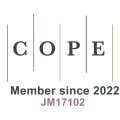REFERENCES
1. Klomp J. Financial fragility and natural disasters: an empirical analysis. J Financ Stab 2014;13:180-92.
2. Noth F, Schüwer U. Natural disasters and bank stability: evidence from the U.S. financial system. J Environ Econ Manag 2023;119:102792.
3. Akter M, Cumming D, Ji S. Natural disasters and market manipulation. J Bank Finance 2023;153:106883.
4. Davis KF, Downs S, Gephart JA. Towards food supply chain resilience to environmental shocks. Nat Food 2021;2:54-65.
5. Hua R, Liu Q, Tse Y, Yu Q. The impact of natural disaster risk on the return of agricultural futures. J Asian Econ 2023;87:101632.
6. Vineyard D, Ingwersen WW, Hawkins TR, Xue X, Demeke B, Shuster W. Comparing green and grey infrastructure using life cycle cost and environmental impact: a rain garden case study in Cincinnati, OH. J Am Water Resour Assoc 2015;51:1342-60.
7. Dong X, Guo H, Zeng S. Enhancing future resilience in urban drainage system: green versus grey infrastructure. Water Res 2017;124:280-9.
8. Lima MF, Ward Thompson C, Aspinall P. Friendly communities and outdoor spaces in contexts of urban population decline. Land 2020;9:439.
9. Nakamura F, Ishiyama N, Yamanaka S, et al. Adaptation to climate change and conservation of biodiversity using green infrastructure. River Res Apps 2020;36:921-33.
10. Wu Z, Lei S, Yan Q, Bian Z, Lu Q. Landscape ecological network construction controlling surface coal mining effect on landscape ecology: a case study of a mining city in semi-arid steppe. Ecol Indic 2021;133:108403.
11. Collentine D, Futter M. Realising the potential of natural water retention measures in catchment flood management: trade-offs and matching interests. J Flood Risk Manag 2018;11:76-84.
12. Taylor JR, Hanumappa M, Miller L, Shane B, Richardson ML. Facilitating multifunctional green infrastructure planning in Washington, DC through a tableau interface. Sustainability 2021;13:8390.
13. Korkou M, Tarigan AK, Hanslin HM. The multifunctionality concept in urban green infrastructure planning: a systematic literature review. Urban For Urban Green 2023;85:127975.
14. Dhakal KP, Chevalier LR. Managing urban stormwater for urban sustainability: barriers and policy solutions for green infrastructure application. J Environ Manag 2017;203:171-81.
15. Falco C, Corbi R. Natural disasters and preferences for the environment: evidence from the impressionable years. Econ Lett 2023;222:110946.
16. Ingwersen N, Frankenberg E, Thomas D. Evolution of risk aversion over five years after a major natural disaster. J Dev Econ 2023;163:103095.
17. Venkataramanan V, Lopez D, McCuskey DJ, et al. Knowledge, attitudes, intentions, and behavior related to green infrastructure for flood management: a systematic literature review. Sci Total Environ 2020;720:137606.
18. Chen Y, Guo K, Ji Q, Zhang D. “Not all climate risks are alike”: heterogeneous responses of financial firms to natural disasters in China. Finance Res Lett 2023;52:103538.
19. Otsuka C, Fukutomi H, Niwa Y. Effect of cost-benefit perceptions on evacuation preparedness for urban flood disasters. Int J Disaster Risk Reduct 2022;81:103254.
20. Cai J, Hu S, Que T, Li H, Xing H, Li H. Influences of social environment and psychological cognition on individuals’ behavioral intentions to reduce disaster risk in geological hazard-prone areas: an application of social cognitive theory. Int J Disaster Risk Reduct 2023;86:103546.
21. Bandura A. Social foundations of thought and action: a social cognitive theory. Englewood Cliffs, NJ: Prentice-Hall; 1986.
22. Bandura A, Freeman WH, Lightsey R. Self-efficacy: the exercise of control. New York: Freeman; 1997.
24. Shi J, Xu K, Duan K. Investigating the intention to participate in environmental governance during urban-rural integrated development process in the Yangtze River Delta Region. Environ Sci Policy 2022;128:132-41.
25. Ajzen I. From intentions to actions: a theory of planned behavior. In: Kuhl J, Beckmann J, editors. Action-control: from cognition to behavior. Heidelberg: Springer; 1985. pp. 11-39.
26. Ajzen I. Attitudes, traits, and actions: dispositional prediction of behavior in personality and social psychology. Adv Exper Soc Psychol 1987;20:1-63.
28. Dargin J, Berk A, Mostafavi A. Assessment of household-level food-energy-water nexus vulnerability during disasters. Sustain Cities Soc 2020;62:102366.
29. He J, Yang W, He Q, et al. Chinese pregnant women’s knowledge, attitude, and practice of self-protection against coronavirus disease 2019 during the post-pandemic period: a structural equation modeling-based survey. Int J Disaster Risk Reduct 2023;87:103559.
30. Du S, Scussolini P, Ward PJ, et al. Hard or soft flood adaptation? Advantages of a hybrid strategy for Shanghai. Glob Environ Chang 2020;61:102037.
31. Wachinger G, Renn O, Begg C, Kuhlicke C. The risk perception paradox-implications for governance and communication of natural hazards. Risk Anal 2013;33:1049-65.
32. Adelman M, Ivaschenko O, Packard TG, Suri V. Hardship and vulnerability in the Pacific island countries (English). Washington, DC: World Bank Group; 2015. Available from: http://documents.worldbank.org/curated/en/649891468098658407/Hardship-and-vulnerability-inthe-Pacific-island-countries [Last accessed on 14 Jun 2024].
33. Xu D, Liu Y, Deng X, et al. Earthquake disaster risk perception process model for rural households: a pilot study from Southwestern China. Int J Environ Res Public Health 2019;16:4512.
34. AlQahtany AM, Abubakar IR. Public perception and attitudes to disaster risks in a coastal metropolis of Saudi Arabia. Int J Disaster Risk Reduct 2020;44:101422.
35. Cassar A, Healy A, von Kessler C. Trust, risk, and time preferences after a natural disaster: experimental evidence from Thailand. World Dev 2017;94:90-105.
36. Harries T, Penning-rowsell E. Victim pressure, institutional inertia and climate change adaptation: the case of flood risk. Glob Environ Chang 2011;21:188-97.
37. EMCEI. The 6th Euro-Mediterranean Conference for Environmental Integration, 15-18 May 2024. Marrakesh, Morocco. Available from: https://2024.emcei.net/index.php?p=program [Last accessed on 14 Jun 2024].
38. Rufat S, Tate E, Burton CG, Maroof AS. Social vulnerability to floods: review of case studies and implications for measurement. Int J Disaster Risk Reduct 2015;14:470-86.
39. Wang J, Tsai N. Factors affecting elementary and junior high school teachers’ behavioral intentions to school disaster preparedness based on the theory of planned behavior. Int J Disaster Risk Reduct 2022;69:102757.
40. Spialek ML, Houston JB. The influence of citizen disaster communication on perceptions of neighborhood belonging and community resilience. J Appl Commun Res 2019;47:1-23.
41. Zhang F, Bao X, Deng X, Wang W, Song J, Xu D. Does trust help to improve residents’ perceptions of the efficacy of disaster preparedness? Evidence from Wenchuan and Lushan earthquakes in Sichuan province, China. Int J Environ Res Public Health 2022;19:4515.
42. Wang R, Eckelman MJ, Zimmerman JB. Consequential environmental and economic life cycle assessment of green and gray stormwater infrastructures for combined sewer systems. Environ Sci Technol 2013;47:11189-98.
43. Wu J, Yang X, Deng X, Xu D. Does disaster knowledge affect residents’ choice of disaster avoidance behavior in different time periods? Evidence from China's earthquake-hit areas. Int J Disaster Risk Reduct 2022;67:102690.
44. e-Stat. Portal site for the official statistics of Japan. Available from: https://www.e-stat.go.jp/ [Last accessed on 14 Jun 2024].
46. D'souza C, Taghian M, Lamb P, Peretiatkos R. Green products and corporate strategy: an empirical investigation. Soc Bus Rev 2006;1:144-57.
47. Lim TS, Dzulkifli DZ, Osman Z, Mohidin R, Abdul Jamal AA. Determinants of perception toward life insurance and its impact on intention to purchase. LBIBF 2020;18:16-26.
48. Lim TS, Mail R, Karim MRA, Ulum ZKAB, Miflia M, Jaidia J. An investigation of financial investment intention using covariance-based structural equation modelling. Glob Bus Financ Rev 2020;25:37-50.
49. Oktari RS, Latuamury B, Idroes R, Sofyan H, Munadi K. Validating knowledge creation factors for community resilience to disaster using structural equation modelling. Int J Disaster Risk Reduct 2022;81:103290.
50. R Core Team. The R project for statistical computing. Vienna, Austria: R foundation for statistical computing; 2019. Available from: https://www.R-project.org/ [Last accessed on 14 Jun 2024].
52. Gefen D, Straub D, Boudreau M. Structural equation modeling and regression: guidelines for research practice. Commun Assoc Inf Syst 2000;4.
53. Steiger JH. Understanding the limitations of global fit assessment in structural equation modeling. Pers Individ Dif 2007;42:893-8.
54. Rosseel Y, Jorgensen TD, De Wilde L, et al. Package ‘lavaan.’ Available from: https://cran.r-project.org/web/packages/lavaan/lavaan.pdf [Last accessed on 14 Jun 2024].
55. Botzen WJW, Aerts JCJH, van den Bergh JCJM. Dependence of flood risk perceptions on socioeconomic and objective risk factors. Water Resour Res 2009;45:2009WR007743.
56. Sang ÅO, Knez I, Gunnarsson B, Hedblom M. The effects of naturalness, gender, and age on how urban green space is perceived and used. Urban For Urban Green 2016;18:268-76.
57. Hynes S, Burger R, Tudella J, Norton D, Chen W. Estimating the costs and benefits of protecting a coastal amenity from climate change-related hazards: nature based solutions via oyster reef restoration versus grey infrastructure. Ecol Econ 2022;194:107349.
58. Baccini L, Leemann L. Do natural disasters help the environment? How voters respond and what that means. Political Sci Res Methods 2021;9:468-84.
59. White GF, Kates RW, Burton I. Knowing better and losing even more: the use of knowledge in hazards management. Global Environ Change B Environ Hazards 2001;3:81-92.
60. Estrella M, Saalismaa N. Ecosystem-based disaster risk reduction (Eco-DRR): an overview. In: Renaud F, Sudmeier-Rieux K, Estrella M, editors. The role of ecosystem management in disaster risk reduction. Tokyo: UNU Press; 2013. pp. 26-54.
61. William R, Endres AB, Stillwell AS. Integrating green infrastructure into stormwater policy: reliability, watershed management, and environmental psychology as holistic tools for success. UCLA J Environ Law Policy 2020;38:37-60.
62. Alves A, Vojinovic Z, Kapelan Z, Sanchez A, Gersonius B. Exploring trade-offs among the multiple benefits of green-blue-grey infrastructure for urban flood mitigation. Sci Total Environ 2020;703:134980.
63. Mulligan J, Bukachi V, Clause JC, Jewell R, Kirimi F, Odbert C. Hybrid infrastructures, hybrid governance: new evidence from Nairobi (Kenya) on green-blue-grey infrastructure in informal settlements. Anthropocene 2020;29:100227.
64. Chen W, Wang W, Huang G, Wang Z, Lai C, Yang Z. The capacity of grey infrastructure in urban flood management: a comprehensive analysis of grey infrastructure and the green-grey approach. Int J Disaster Risk Reduct 2021;54:102045.
65. Kim J, Kang J. Development of hazard capacity factor design model for net-zero: evaluation of the flood adaptation effects considering green - gray infrastructure interaction. Sustain Cities Soc 2023;96:104625.
66. de Groot JIM, Steg L. Value orientations to explain beliefs related to environmental significant behavior: how to measure egoistic, altruistic, and biospheric value orientations. Environ Behav 2008;40:330-54.
67. Ucar GK, Kaynak Malatyalı M, Özdemir Planalı G, Kanik B. Personality and pro-environmental engagements: the role of the dark triad, the light triad, and value orientations. Pers Individ Dif 2023;203:112036.






